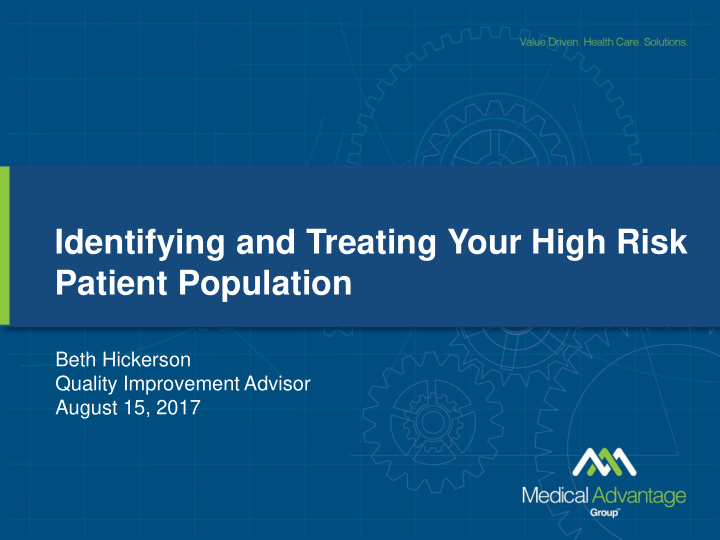



Identifying and Treating Your High Risk Patient Population Beth Hickerson Quality Improvement Advisor August 15, 2017
HIGH RISK PATIENTS What and Why?
What is a high-risk patient? High level of resource use (e.g., visits, meds, treatments) Frequent visits for urgent or emergent care (e.g., two or more visits in the last six months) Frequent hospitalizations (e.g., two or more in last year) Multiple co-morbidities, including mental health Noncompliance with prescribed treatment/medications Terminal illness Psychosocial status, lack of social or financial support that impedes ability for care Advanced age, with frailty Multiple risk factors Value Driven.Health Care. Solutions. 3
How does it relate to GLPTN? Milestone 9 PCP/ 7 SPEC of the Practice Assessment Tool Practice has a reliable process in place for identifying risk level of each patient and providing care appropriate to the level of risk. Phase Score Description: 0 = Not Yet 1 = Getting Started 2 = Implementing, partially operating 3 = Functioning, performing Value Driven.Health Care. Solutions. 4
Milestone 4 Goals Phase 2 Goal Practice has a process for identifying high risk patients but the identification process for other risk levels is inconsistent or not yet standardized. Phase 4 Goal Practice has successfully implemented and documented a tested process that identifies patient risk level and includes follow up by the patient’s care team with care appropriate to the risk level identified. Value Driven.Health Care. Solutions. 5
Why is high risk identification important? Source: “Proactively Identifying the High Cost Population” from the Health Care Transformation Task Force Value Driven.Health Care. Solutions. 6
Categories of High Cost Populations 1. Patients with Advanced Illness 2. Patients with Episodic High Spending 3. Patients with Persistent High Spending Patterns Source: “Proactively Identifying the High Cost Population” from the Health Care Transformation Task Force Value Driven.Health Care. Solutions. 7
Extensive Diseases/Chronic Illnesses Heart failure COPD Cancer Coronary disease Chronic Kidney Disease Peripheral Vascular Disease Neurodegenerative/neuromuscular disease Source: “Proactively Identifying the High Cost Population” from the Health Care Transformation Task Force Value Driven.Health Care. Solutions. 8
RISK LEVEL IDENTIFICATION AND CARE MANAGEMENT How?
Assign Risk Status Identify a risk stratification approach and use it consistently • What is the intended outcome? – Reduce hospitalizations – Reduce readmissions – Reduce ED utilization – Prevent progression of disease – Improve quality of life • What data supports identification AND demonstrates improvement? – Vitals (e.g. blood pressure, weight) – Labs (e.g. HbA1c, cholesterol) – Inpatient and ED Utilization (e.g. discharge summaries, hospital reports) Value Driven.Health Care. Solutions. 10
Assign Risk Status (cont.) Identify a risk stratification approach and use it consistently • How can you collect and track data? – EHR – Billing system – Registry – Exported or manual spreadsheets • Start with 1 identified patient population – Which population? – How will you label them? – What proactive steps will you take? – Who will be responsible? Value Driven.Health Care. Solutions. 11
Assign Risk Status (cont.) Use social determinants of health in risk-stratification models • Age • Lack of social support • Lack of financial support • Housing or food instability Allow for common sense addition to high risk or rising risk factor care team – no algorithm is perfect Value Driven.Health Care. Solutions. 12
Advanced Risk Stratification Use a consistent method to assign and adjust global risk status for all empaneled patients to allow risk stratification into actionable risk cohorts • Hierarchical Condition Categories • Adjusted Clinical Groups • Comorbidity Counts • Elder Risk Assessment • Minnesota Tiering Source: https://www.healthcatalyst.com/understanding-risk- stratification-comorbidities/ Value Driven.Health Care. Solutions. 13
Care Management Responsibility Assign responsibility for care management • Usually does not fall on provider • All staff can be involved Use risk level to identify best provider for the patient • High risk patients assigned to physicians • Lower risk patients assigned to Advanced Nurses 5 minute daily huddles to plan care for the day • Use visits as opportunity to be proactive! Value Driven.Health Care. Solutions. 14
Care Management Responsibility (cont.) Use panel management and registry capabilities to support management of patients at low and intermediate risk • Preventive service reminders via mail, portal or phone Use on-site practice-based or shared care managers to proactively monitor and coordinate care for the highest risk cohort of patients • Share a RN with peer practices • Utilize hospital and payer care managers Identify ways to graduate patients from care management when goals are met as appropriate • How do you know when patients are done? Value Driven.Health Care. Solutions. 15
Use Care Plans Engage patients at highest risk in ongoing development and refinement of their care management plan, to include integration of patient goals, values and priorities • Relates to shared decision making milestone Assess patient engagement and willingness to address care gaps Use Medicare Annual Wellness Visit with Personalized Prevention Plan Services for Medicare patients Deliver care plan with patient and family Implement a standard approach to documenting care plans Value Driven.Health Care. Solutions. 16
QUESTIONS? COMMENTS?
Contacts Beth Hickerson, Quality Improvement Advisor • bhickerson@medadvgrp.com Angela Hale, Quality Improvement Advisor • ahale@medadvgrp.com Value Driven.Health Care. Solutions. 18
NEXT MONTH Quality Improvement Methodology For Practice Managers September 18, 2017 from 11:30 - 1:00 at Sycamore Hospital POB #425 For Providers September 26, 2017 from 6:00 – 8:00 at Sycamore Hospital POB #425
Recommend
More recommend